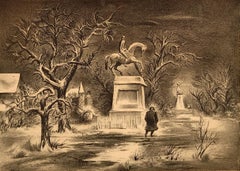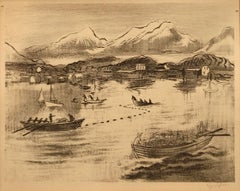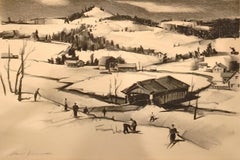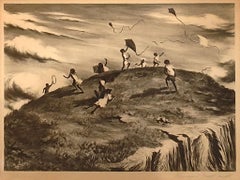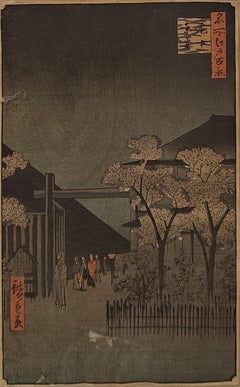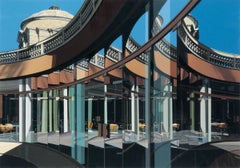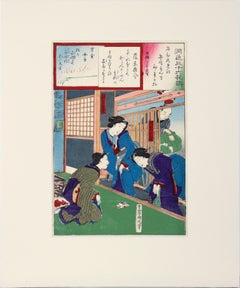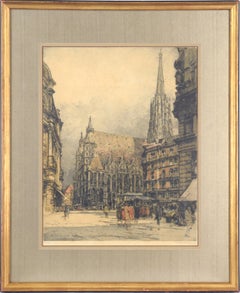Lincoln Glenn Landscape Prints
to
1
2
6
1
Overall Width
to
Overall Height
to
1
2
1
1
1
1
4
5
3
1
1
8
1
6
4
3
2
2
2
2
1
1
1
1
1
1
1
1
1
1
1
1
1
6
6
1
1
1
6
2
9
"City Park, Winter" Aaron Bohrod, Mid-Century, American Realist Nocturne
By Aaron Bohrod
Located in New York, NY
Aaron Bohrod
City Park, Winter, circa 1945
Signed in pencil lower right margin
Lithograph on wove paper
Image 9 1/2 x 13 1/2 inches
From the edition of 250
Aaron Bohrod's work has ...
Category
1940s American Realist Figurative Prints
Materials
Lithograph, Paper
"Fishing Village" Joe Jones, Mid-Century, American Life, Small Town Scene
By Joe Jones
Located in New York, NY
Joe Jones
Fishing Village, 1949
Signed in pencil lower right margin
Lithograph on wove paper
Image 9 5/16 x 12 9/16 inches
Sheet 12 x 15 15/16 inches
From the edition of 250
The initial details of Jones' career are sparse, and this is intentional. The young artist was engaged in a process of self-reinvention, crafting a persona. When he submitted a work to the Sixteen Cities Exhibition at New York City's Museum of Modern Art in 1933, he briefly characterized himself: "Born St. Louis, 1909, self-taught. " Jones intentionally portrayed himself to the art community as an authentic working-class figure, backed by a compelling history. He was the youngest of five children in a family led by a one-armed house painter from St. Louis, a Welsh immigrant, and his German American spouse. At the age of ten, Jones found himself in a Missouri reformatory due to authorities' concerns over his graffiti activities. After completing elementary school, he traveled by freight car to California and back, even being arrested for vagrancy in Pueblo, Colorado. Returning to St. Louis, he attempted to settle down by working alongside his father. Yet, Jones felt a profound restlessness and was drawn toward a more elevated artistic pursuit in his late teenage years. He discovered a local collective of budding artists that formed St. Louis’s "Little Bohemia," sharing a studio and providing mutual support until he managed to secure his own modest workspace in a vacant garage.
Jones’s initial creations comprised still lifes, landscapes, and poignant portraits of those close to him. These subjects were not only accessible but also budget-friendly, as hiring models was beyond his means. He depicted himself, his father, mother, and eventually, his wife. In December 1930, at the age of 21, Jones wed Freda Sies, a modern dancer and political activist who was four years older than him.
By 1933, Jones had started gaining noteworthy local recognition through a solo exhibition at the Artists’ Guild of Saint Louis. Of the twenty-five paintings on display, one, titled River Front (private collection, previously with Hirschl and Adler Galleries), was selected to illustrate a feature article about his show in The Art Digest (February 15, 1933, p. 9). Shortly before this exhibition, a young surgeon named Dr. Robert Elman took an interest in Jones’s art, purchasing several pieces and forming a group of potential patrons committed to providing the emerging artist with a monthly stipend in exchange for art. This group was officially known as the "Co-operative Art Society," but it was informally dubbed the "Joe Jones Club. " Jones became an active participant in the St. Louis artistic scene, particularly within its bohemian segments. He embraced modernism and was a founding member of the "New Hat" movement in 1931, a playful rebellion against the conservative and traditional mainstream art establishment.
The summer of 1933 marked a significant shift in Jones’s journey. Sponsored by a dedicated ally, Mrs. Elizabeth Green, Jones, along with Freda and Green, embarked on an eastward road trip. In Washington, D. C., they explored the Corcoran Gallery of Art, the Freer Gallery (part of the Smithsonian Institution), the Library of Congress, and Mount Vernon. Following this whirlwind of art and American culture, they made their way to New York, where they visited various museums and galleries, including a stop at The New School for Social Research, which featured notable contemporary murals by fellow Missourian Thomas Hart Benton and the politically active Mexican artist, José Clemente Orozco. From June through August, Jones and Freda resided in the artist colony of Provincetown, Massachusetts, later returning home via Detroit to see Diego Rivera’s Detroit Industry mural housed at the Detroit Institute of Fine Arts.
While Elizabeth Green allegedly hoped that Jones would refine his artistic skills under the guidance of Charles Hawthorne or Richard Miller in Provincetown, Jones followed a different path. Rather than pursuing conservative mentors, he connected with an engaging network of leftist intellectuals, writers, and artists who dedicated their time to reading Marx and applying his theories to the American landscape. Jones's reaction to the traditional culture of New England was captured in his statement to a reporter from the St. Louis Post Dispatch: “Class consciousness . . . that’s what I got of my trip to New England. Those people [New Englanders] are like the Chinese—ancestor worshipers. They made me realize where I belong” (September 21, 1933). The stark social divisions he witnessed there prompted him to embrace his working-class identity even more fervently. Upon returning to St. Louis, he prominently identified himself as a Communist. This newfound political stance created friction with some of his local supporters. Many of his middle-class advocates withdrew their backing, likely influenced not only by Jones’s politics but also by his flamboyant and confrontational demeanor.
In December 1933, Jones initiated a complimentary art class for unemployed individuals in the Old Courthouse of St. Louis, the same location where the Dred Scott case was deliberated and where slave auctions formerly took place. Concurrently, the St. Louis Art League was offering paid courses. Emphasizing the theme of social activism, with a studio adorned with Soviet artwork, Jones’s institution operated for just over a year before being removed from the courthouse by local officials. The school’s political focus and unconventional teaching practices, along with its inclusion of a significant number of African American students during a period marked by rigid racial segregation, certainly contributed to its challenges. Under Jones’s guidance, the class created a large chalk pastel mural on board, measuring 16 by 37 feet, titled Social Unrest in St. Louis. Mural painting posed no challenge for the former housepainter, who was adept at handling large wall surfaces. His first significant commission in St. Louis in late 1931 was a mural that celebrated the city’s industrial and commercial fortitude for the local radio station, KMOX. This mural, aimed at conveying optimism amid severe economic hardship, showcased St. Louis's strengths in a modernist approach. When Jones resumed mural work in late 1933, his worldview had evolved considerably. The mural produced for the school in the courthouse, conceived by Jones, featured scenes of modern St. Louis selected to highlight political messages. Jones had observed the technique of utilizing self-contained scenes to craft visual narratives in the murals he encountered in the East. More locally, this compositional strategy was commonly employed by the renowned Missouri artist...
Category
1940s American Realist Landscape Prints
Materials
Paper, Lithograph
"The Slope Near the Bridge" Paul Sample, Mid-Century, American Snowy Landscape
By Paul Sample
Located in New York, NY
Paul Sample
The Slope Near the Bridge, 1950
Signed in pencil lower left
Lithograph on wove paper
Image 8 15/16 x 12 15/16 inches
Sheet 11 5/16 x 15 1/16 inches
From the edition of 25...
Category
1950s American Realist Figurative Prints
Materials
Paper, Lithograph
"Windy Hill" Lawrence Beall Smith, Mid-Century Realist Scene, American Life
By Lawrence Beall Smith
Located in New York, NY
Lawrence Beall Smith
Windy Hill, 1948
Signed in pencil lower right margin
Lithograph on wove paper
Image 10 3/8 x 13 1/16 inches
Sheet 11 15/16 x 16 inches
From the edition of 250
...
Category
1940s American Realist Figurative Prints
Materials
Lithograph, Paper
"Dawn Inside the Yoshiwara" Utagawa Hiroshige, Japanese Landscape, Ukiyo-e
By Utagawa Hiroshige
Located in New York, NY
Utagawa Hiroshige
Dawn Inside the Yoshiwara, circa 1857
Woodblock print
11 x 7 inches
Utagawa Hiroshige is recognized as a master of the ukiyo-e woodblock printing tradition, havin...
Category
1850s Naturalistic Figurative Prints
Materials
Paper, Ink, Woodcut
"Roma (from Urban Landscapes III)" Richard Estes, Photorealist Screenprint
By Richard Estes
Located in New York, NY
Richard Estes
Roma (from Urban Landscapes III), 1981
Signed and numbered "33/250" in pencil, lower margin
Color screenprint on white wove paper
14 x 20 inches
Edition 33/250
Richar...
Category
1980s Photorealist Figurative Prints
Materials
Screen
"Newport Beach" Currier & Ives, Hand-Colored Lithograph of Newport Beach
By Currier & Ives
Located in New York, NY
Currier & Ives
Newport Beach
Hand-colored lithograph
Sheet 10 x 13 1/4 inches
After undertaking apprenticeships in Boston and Philadelphia, Currier set up a print publishing compan...
Category
Late 19th Century Realist Figurative Prints
Materials
Lithograph
"The Great Fire of Boston" Currier & Ives, Urban landscape late 19th century
By Currier & Ives
Located in New York, NY
Currier & Ives
The Great Fire of Boston , 1872
Hand-colored lithograph
7 5/16 x 12 11/16 inches
After undertaking apprenticeships in Boston and Philadelphia, Currier set up a print...
Category
1870s Realist Landscape Prints
Materials
Lithograph
"New York - Taken from the Northwest angle of Fort Columbus, Governor's Island"
Located in New York, NY
New York - Taken from the north west angle of Fort Columbus Governor's Island, 1846
Engraved by Henry Papprill after a sketch by F. Catherwood, published by Henry J. Megarey
Hand-colored engraving on paper
Image 16 x 26 1/2 inches
Henry A. Papprill (1816–1903) was a British engraver. Noted as an aquatint engraver from 1840. His plates were published from 1840 till 1883 mainly by Ackermann of the Strand.
Papprill was born in Holborn, London. Lived for much of his life at Wharton Street, Lloyd Square, London. Papprill is thought to have been based in New York City for brief period in the mid-1840s. His work in the USA appears to classify him as an American engraver but he was based and gained his reputation and bulk of his work in England.
He produced a series of works for Ackermann & Co from 1840 beginning with four plates called "The Jolly Squire", with verses, after James Pollard.
In the following years Papprill engraved a number of military plates for Ackermann as well a series of engravings of New York (1846-9) for H.I.Megarey (published in New York). The most notable of these are: "The North West Angle of Fort Columbus, Governor's Island" (the Catherwood-Papprill view) and New York from the Steeple of St. Paul's Church, Looking East, South & West." (The Hill-Papprill view) listed in the American Historical Prints - Early Views of American Cities, etc: I.N.Phelps Stokes & Daniel C. Haskell. New York Public Library 1932.
Papprill also produced for Ackermann a series of sporting prints after G. H. Laporte between 1860 and 1865. These were entitled: Racing, Hunting and Coursing. He also produced a series of shipping prints...
Category
1840s Landscape Prints
Materials
Paper, Engraving, Aquatint
Related Items
"Enshoku Sanju-roku Kasen" (Thirty-six Enchanting Flowers) Woodblock on paper
By Toyohara Kunichika
Located in Soquel, CA
"Enshoku Sanju-roku Kasen" (Thirty-six Enchanting Flowers) Woodblock on paper
Elegant woodblock print by Toyohara Kunuchika (Japanese, 1835-1900). Three women are in talking with each other inside, while a man waits outside holding a bag of some kind. The colors in this piece are rich and saturated, primarily blues, greens, and purple.
Mat size: 16"H x 20"W
Paper size: 14.75"H x 9.88"W
Born in 1835, Toyohara Kunichika grew up in the Kyobashi district of Edo in the midst of merchants and artisans. In 1848, at age 13, he was accepted as an apprentice into the studio of Utagawa Kunisada I...
Category
1880s Edo Figurative Prints
Materials
Ink, Rice Paper, Woodcut
$380 Sale Price
20% Off
H 20 in W 16 in D 0.25 in
St. Stephen's Cathedral in Vienna - Hand Colored Cityscape Lithograph
By Luigi Kasimir
Located in Soquel, CA
Detailed and dramatic hand-colored etching by Luigi Kasimir (Austrian, 1881-1962). St. Stephen's cathedral towers above the streets of Vienna, with people going about their daily bus...
Category
1920s Photorealist Landscape Prints
Materials
Paper, Watercolor, Lithograph
$1,120 Sale Price
20% Off
H 29.75 in W 23.75 in D 0.75 in
One Hundred Aspects of the Moon, Mt Otawa Moon - Bright God Tamura
By Tsukioka Yoshitoshi
Located in Soquel, CA
"Mount Otawa Moon: Bright God Tamura" - Woodblock on Paper by Tsukioka Yoshitoshi
From the series "One Hundred Aspects of the Moon"
This piece depicts the general Sakanoe no Tamura...
Category
1880s Edo Figurative Prints
Materials
Paper, Ink, Woodcut
$487 Sale Price
35% Off
H 20.5 in W 15.5 in D 0.75 in
Kiyomizu Temple, Scenes of Famous Places along Tôkaidô Road - Woodblock on Paper
By Utagawa Hiroshige II
Located in Soquel, CA
Kiyomizu Temple, Scenes of Famous Places along Tôkaidô Road - Woodblock on Paper
Full Title:
Kyoto: Kiyomizu Temple (Kyô Kiyomizudera), from the series Scenes of Famous Places along...
Category
1860s Edo Landscape Prints
Materials
Ink, Rice Paper, Woodcut
$960 Sale Price
20% Off
H 20 in W 16 in D 0.25 in
Wyeth, Brinton’s Mill, The Four Seasons (after)
By Andrew Wyeth
Located in Southampton, NY
Lithograph on vélin paper. Unsigned and unnumbered, as issued. Good condition. Published and printed by Art in America, New York in an edition of CDVII/D. From the folio, The Four Se...
Category
1960s American Realist Figurative Prints
Materials
Lithograph
Wyeth, The Corner, The Four Seasons (after)
By Andrew Wyeth
Located in Southampton, NY
Lithograph on vélin paper. Unsigned and unnumbered, as issued. Good condition. Published and printed by Art in America, New York in an edition of CDVII/D. From the folio, The Four Se...
Category
1960s American Realist Figurative Prints
Materials
Lithograph
Wyeth, New Leaves, The Four Seasons (after)
By Andrew Wyeth
Located in Southampton, NY
Lithograph on vélin paper. Unsigned and unnumbered, as issued. Good condition. Published and printed by Art in America, New York in an edition of CDVII/D. From the folio, The Four Se...
Category
1960s American Realist Figurative Prints
Materials
Lithograph
Original Remember Your First Thrill of American Liberty 1917 vintage poster
Located in Spokane, WA
Original poster: Rembember Your First Thrill of Ameridan Liberty YOUR DUTY Buy United States Government Bonds 2nd Liberty Loan of 1917. Linen backed and ready to frame. Poste...
Category
1910s American Realist Figurative Prints
Materials
Lithograph
$650
H 30 in W 20 in D 0.2 in
"Nane - Qagyuhl" Native American in Grizzly Costume - Photogravure Print
By Edward Curtis
Located in Soquel, CA
"Nane - Qagyuhl" Native American in Grizzly Costume - Photogravure Print
Photogravure of a Native American man from a photo by Edward Sheriff Curtis (American, 1868-1952). The man i...
Category
Early 20th Century Photorealist Figurative Prints
Materials
Paper, Ink
$1,072 Sale Price
20% Off
H 22 in W 18 in D 1 in
Wyeth, Early October, The Four Seasons (after)
By Andrew Wyeth
Located in Southampton, NY
Lithograph on vélin paper. Unsigned and unnumbered, as issued. Good condition. Published and printed by Art in America, New York in an edition of CDVII/D. From the folio, The Four Se...
Category
1960s American Realist Figurative Prints
Materials
Lithograph
Mitate of a Daimyo's Procession Crossing Ryogoku Bridge - Woodblock Print
By Keisai Eisen
Located in Soquel, CA
Mitate of a Daimyo's Procession Crossing Ryogoku Bridge - Woodblock Print
Woodblock print of a procession by Keisai Eisen (Japanese, 1790–1848). Terrific triptych of a procession of...
Category
Early 19th Century Edo Figurative Prints
Materials
Ink, Rice Paper, Woodcut
$1,320 Sale Price
20% Off
H 24 in W 36 in D 0.25 in
"First Horse Day, 1896" - Chiyoda Palace - Japanese Woodblock by Chikanobu Yoshu
By Toyohara Chikanobu
Located in Soquel, CA
"First Horse Day, 1896" - Chiyoda Palace - Japanese Woodblock by Chikanobu Yoshu
Colorful and expressive court scne by Toyohara Chikanobu,"Yoshu" (Japanese, 1838-1912).
This is the r...
Category
1890s French School Figurative Prints
Materials
Ink, Rice Paper, Woodcut
$700 Sale Price
20% Off
H 15 in W 10.5 in D 0.5 in
